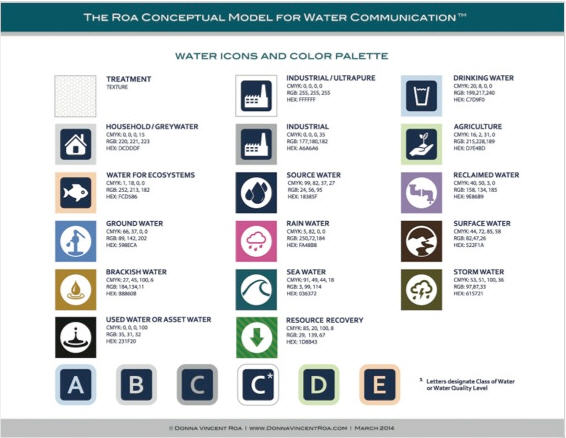One Water Communication: Standardizing How We Communicate Visually About Water


Download The Roa Conceptual Model for Water Communication™ package of materials zip file with the model, the color palette and individual water icons.
I believe that we value what we know. We use scales, models and frameworks to help us understand complex matters and materials. Review the conceptual models and categorization efforts of Daniel Defoe, Charles Darwin, Anders Celsius, John Smith Elgin Marbles, Seamus Heaney, Tycho Brahe, Captain Bligh, and my favorite, Rear Admiral Francis Beaufort, author and developer of the Beaufort Wind Scale.
Study the naming of wind and you’ll find that getting to a standard was not easy. At the time, Rear Admiral Beaufort, hydrographer to the British Admiralty and an Irish Royal Navy officer, developed the Beaufort Wind Scale, there were many wind scales in use. The profusion of scales led to much confusion and inaccurate measurement and communication about wind.
Simple and Clear Facilitates Understanding
If you’ve never seen the Beaufort Scale, it is one of simplicity and clarity with only four categories in the table: Beaufort number (0-12); name; wind speed; description. Midshipmen in the Navy learn Beaufort scale. Sailing courses include instruction on it.
Beaufort succeeded in standardizing the way those who made weather observations could provide objective and concise descriptions about what they saw. The modern scale uses colors (e.g., spanning from a light teal to orange and red), concise labels and descriptions, sea conditions, numbers and photos to indicate the level or force of the wind. Some versions include a variety of pictures illustrating the wind’s force.
Beaufort’s intentions were to shape the views of the world on wind. I believe that we have a similar opportunity with one water communication to shape the views of the world on water.
Social Codes and Systems Based on Color
Throughout history, we’ve had an affinity for categorizations, including using color to categorize. All societies have social codes and systems based on color – from the Roman period through the Middle Ages to the church’s use of color for symbolic and practical purposes to the use of color categorization in present day design and communication.
Color categorization is a familial concept and a universally understood framework that has the potential, when used correctly and consistently, to enhance understanding and carry messages.
My goal for The Roa Conceptual Model for Water Communication™ project was to develop a simple taxonomy and clear framework that would help to standardize visual communication for water and could be used by water associations, water utilities, engineers, scientists, water leaders, water communicators, and others worldwide to communicate visually about water.
This article is first in a series addressing the need for standardizing visual communication for water. Download the full package of materials zip file with the conceptual model, water icons, and the color palette.

Download The Roa Conceptual Model for Water Communication™ package of materials zip file with the model, the color palette and individual water icons.
